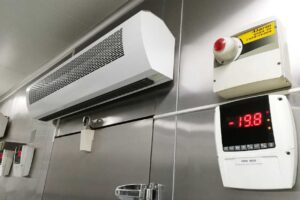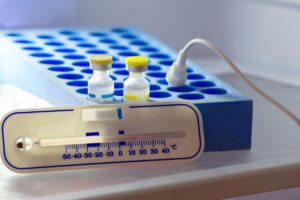We’ve all seen those scary headlines. “Millions of Vaccine Doses Ruined by Temperature Deviation” or “Foodborne Illnesses Traced to Broken Cold Chain.” These tales of cold chain catastrophes highlight a chilling truth. Inconsistent temperatures during storage and transportation put products and consumers at risk. In fact, the World Health Organization estimates that nearly 1.3 million lives are lost annually due to vaccine spoilage from temperature fluctuations. With the cold chain logistics market projected to reach $343 billion by 2026, businesses cannot afford these failures. The solution lies in data loggers, the compact sensors continuously monitoring environmental conditions. Armed with real-time temperature insights, companies can conquer cold chain challenges and deliver quality products safely to customers.
The Rise of the Data Logger Dynasty.
In the cutthroat cold chain arena, data loggers rule supreme. Unlike humans, who tirelessly track temperatures by hand, these compact sensors work 24/7/365, providing a complete record of any environmental deviations. And with global cold chain logistics heating up, companies need the actionable intel data loggers deliver at lightning speed.
A wide variety exists today, from cost-effective, single-use models ideal for exporting goods abroad to reusable, real-time trackers that allow active cold chain monitoring. New enhancements like long-life batteries, expanded memory, and Bluetooth connectivity make spotting risks easier than ever. Any business delivering temperature-controlled products can benefit from stocking its supply chain with these transformative tools.
Types of Data Loggers.

Single-Use Data Loggers.
As the name implies, these economical sensors are meant for one-time temperature tracking. Ideal uses include:
- Monitoring cold chain logistics for international freight shipments
- Verifying handling conditions for temperature-sensitive materials
- Providing temperature history for imported/exported food, pharmaceuticals, and chemicals
Reusable Data Loggers.
These are for regular cold chain oversight. Reusable data loggers deliver ongoing value. Many loggers include
- Robust, waterproof housing for harsh conditions
- Programmable alarms when thresholds are exceeded
- Bluetooth or WiFi connectivity to access data remotely
- Ample data storage and battery capacities for extended monitoring
Real-Time Data Loggers.
These advanced trackers transmit live temperature readings via cellular or satellite networks.
- Active monitoring and alerts from anywhere
- Rapid response to prevent minor issues from escalating
- GPS tracking and geofencing capabilities
Though more costly, real-time oversight brings peace of mind to high-risk, high-value shipments.
Features of Data Loggers
Of course, data loggers come packed with more bells and whistles than a Swiss army knife! Let’s dig into some of their key features.
Accuracy
Data loggers must provide temperature readings more precisely than a celebrity diva demanding her Evian water be “exactly 67 degrees!” Typical accuracy ranges from +-0.5°C down to a freakishly exact +-0.1°C.
Battery Life
Logging life spans run the gamut from single-use models that crash after a one-time overseas shipment to reusable data loggers energized like the Energizer Bunny for years. Just beware of any “too good to be true” battery claims – the lure of long-life lithium batteries has led many astray into the land of exaggerated marketing.
Communication Protocols
Data loggers speak their nerdy language, with acronyms like Bluetooth, RFID, NFC, and WiFi dominating. Selecting compatible communication options depends on whether you want data downloaded locally or accessible wirelessly in the cloud. Nothing stings like getting an exciting new data logger but finding out your systems need to speak the same language.
Data Storage
Think of data loggers like little mind-boggling microchips, capturing and storing temperature readings around the clock. Storage volumes range from tens of thousands of data points for simple models to millions of readings for high-capacity industrial trackers. GO big or go home regarding storage if you want to maximize trend analysis over extended periods
So, while data loggers may seem small, their performance capabilities and feature sets are mighty. The key is finding the optimal balance of accuracy, battery life, connectivity, storage, and functionality that aligns with your budget. Good news – with the data logger industry exploding, more excellent options than ever are explicitly tailored for cold chain challenges.
Temperature Control at your Fingertips.

Data loggers offer sweet relief for cold chain temperature troubles like an ice-cold drink on a hot summer day. Their continuous tracking provides insights well beyond the capabilities of sporadic manual checks. Gone are the days of crossing your fingers to ensure products stay within acceptable ranges during transport or storage.
With comprehensive environmental data at your fingertips, you can rapidly identify and address cold chain deficiencies. For example, data showing recurring temperature spikes during trucking routes allows you to pinpoint issues like inadequate insulation or malfunctioning refrigeration units. When armed with such intelligence, retrofitting vehicles or adjusting transport schedules are simple solutions.
Cloud-based data logger platforms also provide innovative options like custom analytics, visual dashboards, and real-time alerts when temperatures deviate from set parameters. By connecting the dots systemwide, businesses obtain unprecedented cold chain oversight and control from production to final delivery.
Case Studies in Data Logger Domination.
Are you curious about how data loggers conquer cold chain challenges worldwide? Here are just a few standout examples.
1. Frozen Food Leader Cuts Waste in Half.
PolarPack Foods reported massive losses from fluctuating freezer temperatures while storing and delivering frozen pizzas and meals. Deploying a network of Bluetooth-enabled data loggers provided real-time visibility into these issues, reducing product waste by over 50% within 6 months.
2. Craft Brewer Cans Quality Concerns.
Beer City Brewery struggled with keeping its sensitive craft beers chilled properly while canning and transporting products. Data loggers helped identify warm spots on the production line and delivery trucks needing improved refrigeration. This prevented beers from skunking and boosted customer satisfaction.
3. The Produce Company Predicts Shelf Life Precisely.
Fresh Global Supplies uses single-use sensors during its tomato exports, gaining temperature data throughout the overseas journey. This allows for accurately predicting and labelling shelf life, reducing food waste and consumer distrust.
4. Pharmaceutical Leader Protects Potency.
When vaccine shipments faced compliance questions, they deployed reusable data loggers with humidity sensors in each package. This validated handling conditions, ensuring doses stayed within 2-8°C and preventing further regulatory action.
5. Dairy Delivers Quality Goods.
Yummy Dairy tracks each delivery truck route in real time using wirelessly networked data loggers to guarantee yoghurt freshness. Rapid detection of temperature spikes allows us to take immediate corrective action. Customer rejections are down by 75% across their Northeast delivery region.
Whether safeguarding frozen foods, protecting pharmaceuticals to market, or ensuring dairy quality, data loggers deliver a competitive edge across the cold chain arena.
Gear Up to Conquer the Cold Chain.

Are you ready to dominate like a data logger dynamo? Here are crucial tips when deploying these game-changing tools
- Choose Strategic Monitoring Locations: Focus data loggers on supply chain choke points with a higher risk of temperature deviations. For example, monitor refrigerated trucks, loading docks, storage freezers, etc.
- Select Sensor Types Suited to Your Needs: Parameters like one-time use vs. reusable, wireless connectivity, sampling rates, and probe types (air, surface, liquid) differ widely. Choose what aligns best with your budget, products, workforce, and data accessibility needs.
- Follow Proper Sensor Placement Protocols: Position data loggers correctly within environments for accurate, consistent readings. Regular calibration and maintenance also keep things running smoothly.
- Leverage Advanced Analytics: Don’t just collect data; harness insights! Analytic dashboards spot trends and issues via interactive charts and notifications. This transforms numbers into powerful cold-chain intelligence.
- Take Action on Alarming Anomalies: When data loggers detect temperature outliers, they have protocols in place to correct them immediately. This prevents minor blips from becoming big problems.
With a robust data logging strategy deployed, your business is primed to prevent cold chain disruptions, deliver quality products on time, and exceed customer expectations. Who knows, you may even usher in a new era of data logger domination in your industry. The future of the cold chain looks bright and well-refrigerated!
Practices for Managing Data Loggers.
Like any technological innovation, adopting data loggers requires adapting policies, processes, and mindsets across an organization. Consider these tips to smooth the data logging transition.
- Provide Training:- Educate staff on properly deploying, maintaining, and downloading data from loggers. Cover how to interpret trends and leverage insights.
- Define Alert Response Plans:- Create protocols specifying actions when temperature excursions occur, including notifying managers, adjusting equipment, and segregating affected products.
- Share Successes:- Broadcast data logger wins internally. Quantify impacts like less waste, lower compliance risk, and costs avoided to showcase value.
- Fine Tune Over Time:- Continuously evaluate logger data patterns to identify opportunities to optimize equipment, product placement, staff habits, and shipping routes.
- Budget for Expansion:- As benefits multiply, plan data logger growth into more facilities, vehicles, and packaging. Bulk purchasing often lowers costs.
Adapting philosophies and operations to make data loggers a cold chain cornerstone will amplify advantages.
Conquering the Cold Chain.
Innovative data logger solutions are clearing a path to cold chain success like a mighty glacier carving through a frozen tundra. Their 24/7 temperature tracking and analytics empower businesses to stop cold chain threats before disaster strikes. Waste and spoilage plummet as products safely reach more customers. Data loggers are designed with accuracy, scalability, and user-friendliness, offering the most potent toolkit to conquer instabilities. With real-time environmental insights, you can forecast problems and proactively protect products in transit, storage, and motion.
With so many cutting-edge options, cold chain operations can find the perfect data logging solutions to fit their unique inventory, facilities, transportation methods, risk profiles and budget needs. The data logger revolution has only just begun! Now is the time to equip your cold chain with data-logging capabilities and seize the future. With real-time temperature intelligence on your side, get ready to conquer the cold chain once and for all!





